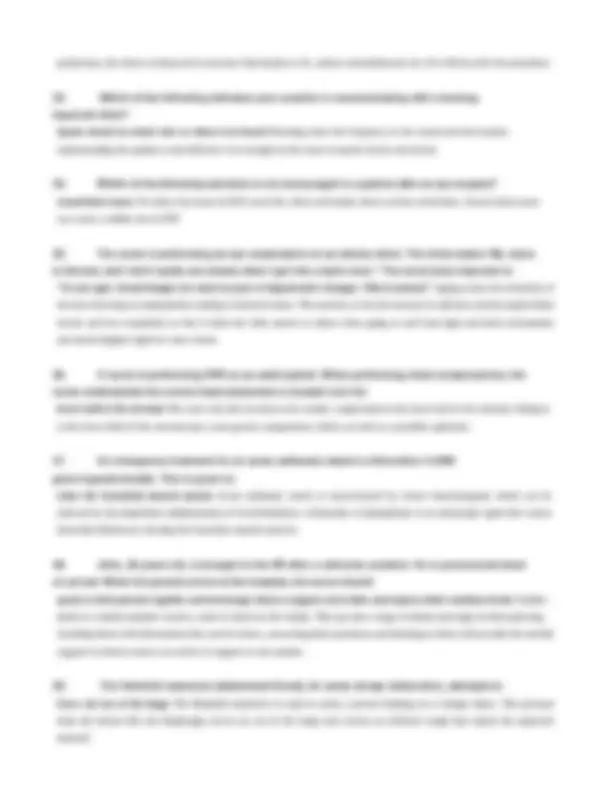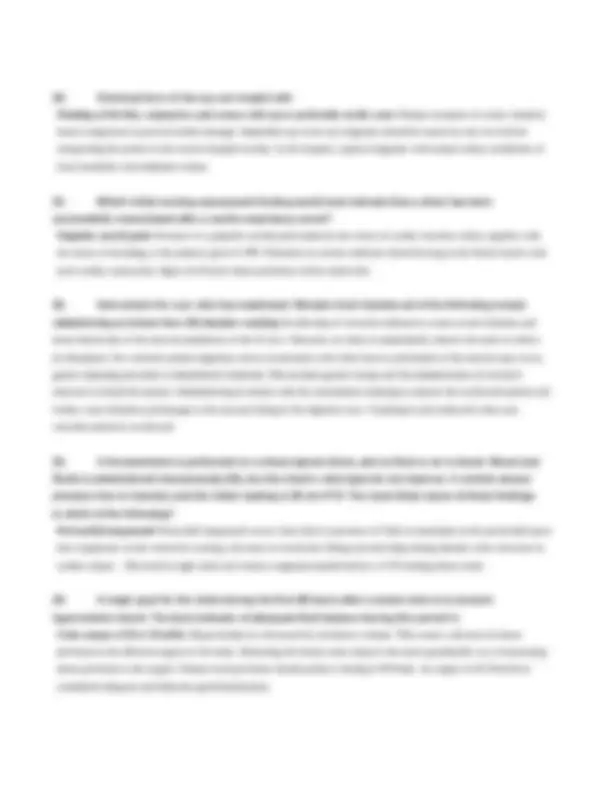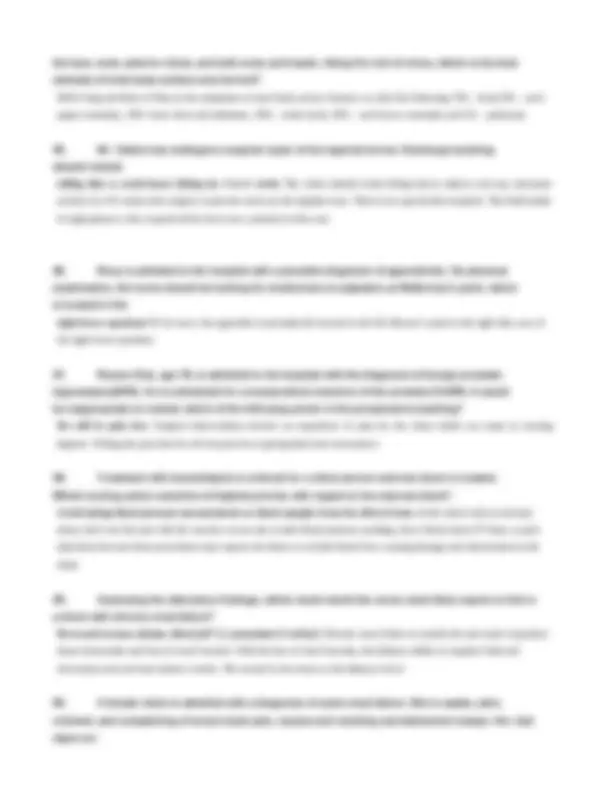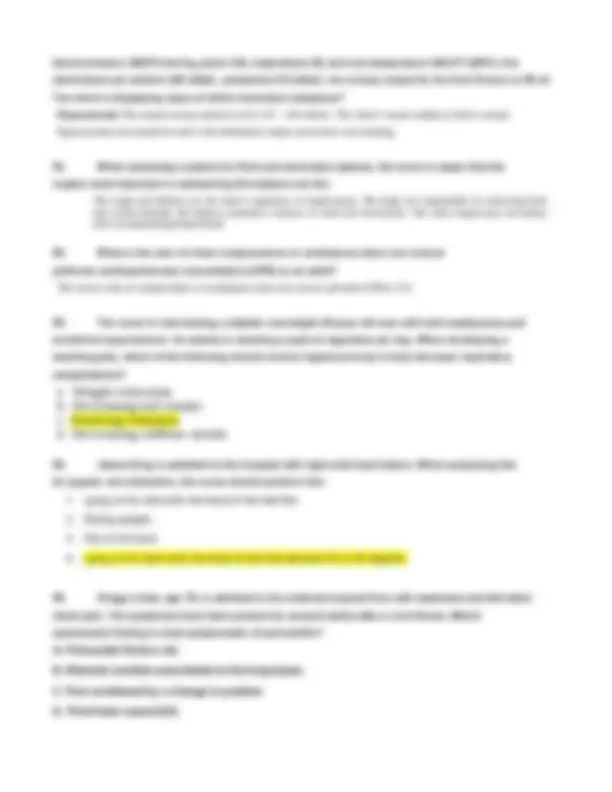








Study with the several resources on Docsity

Earn points by helping other students or get them with a premium plan


Prepare for your exams
Study with the several resources on Docsity

Earn points to download
Earn points by helping other students or get them with a premium plan
Community
Ask the community for help and clear up your study doubts
Discover the best universities in your country according to Docsity users
Free resources
Download our free guides on studying techniques, anxiety management strategies, and thesis advice from Docsity tutors
A series of multiple-choice questions related to nursing practices and patient care. It covers a range of topics, including post-operative care following a laminectomy, managing gouty arthritis, caring for patients with osteoarthritis, stump care after amputation, identifying csf leakage after head injury, managing myasthenia gravis, and responding to increased intracranial pressure. The questions also address communication with hearing-impaired clients, post-eye surgery care, cpr techniques, asthma management, and emergency response protocols. This material is designed to test and reinforce knowledge of essential nursing procedures and patient management strategies, making it a valuable resource for nursing students and practicing nurses alike.
Typology: Exams
1 / 10

This page cannot be seen from the preview
Don't miss anything!







1. A client had a laminectomy and spinal fusion yesterday. Which statement is to be excluded from your plan of care? Before log rolling, remove the pillow from under the client’s head and use no pillows between the client’s legs. Following a laminectomy and spinal fusion, it is important that the back of the patient be maintained in straight alignment and to support the entire vertebral column to promote complete healing. 2. A client is admitted from the emergency department with severe-pain and edema in the right foot. His diagnosis is gouty arthritis. When developing a plan of care, which action would have the highest priority? Ensure an intake of at least 3000 ml of fluid per day. Gouty arthritis is a metabolic disease marked by urate deposits that cause painful arthritic joints. The patient should be urged to increase his fluid intake to prevent the development of urinary uric acid stones 3. A 70-year-old female comes to the clinic for a routine checkup. She is 5 feet 4 inches tall and weighs 180 pounds. Her major complaint is pain in her joints. She is retired and has had to give up her volunteer work because of her discomfort. She was told her diagnosis was osteoarthritis about 5 years ago. Which would be excluded from the clinical pathway for this client? Place items so that it is necessary to bend or stretch to reach them. Patients with osteoarthritis have decreased mobility caused by joint pain. Over-reaching and stretching to get an object are to be avoided as this can cause more pain and can even lead to falls. The nurse should see to it therefore that objects are within easy reach of the patient 4. The nurse includes the important measures for stump care in the teaching plan for a client with an amputation. Which measure would be excluded from the teaching plan? Apply a "shrinker" bandage with tighter arms around the proximal end of the affected limb. The “shrinker” bandage is applied to prevent swelling of the stump. It should be applied with the distal end with the tighter arms. Applying the tighter arms at the proximal end will impair circulation and cause swelling by reducing venous flow 5. The client has clear drainage from the nose and ears after a head injury. How can the nurse determine if the drainage is CSF? Test for glucose The CSF contains a large amount of glucose which can be detected by using glucostix. A positive result with the drainage indicate CSF leakage. 6. Which nursing diagnosis is of the highest priority when caring for a client with myasthenia gravis? Ineffective airway clearance related to muscle weakness Myasthenia gravis causes a failure in the transmission of nerve impulses at the neuromuscular junction which may be due to a weakening or decrease in acetylcholine receptor sites. This leads to sporadic, progressive weakness or abnormal fatigability of striated muscles that eventually causes loss of function. The respiratory muscles can become weak with decreased tidal volume and vital capacity making breathing and clearing the airway through coughing difficult. The respiratory muscle weakness may be severe enough to require and emergency airway
and mechanical ventilation.
7. A client with head injury is confused, drowsy and has unequal pupils. Which of the following nursing diagnosis is most important at this time? Altered cerebral tissue perfusion The observations made by the nurse clearly indicate a problem of decrease cerebral perfusion. Restoring cerebral perfusion is most important to maintain cerebral functioning and prevent further brain damage 8. What would be the MOST therapeutic nursing action when a client’s expressive aphasia is severe? Encourage the client to speak at every possible opportunity. Expressive or motor aphasia is a result of damage in the Broca’s area of the frontal lobe. It is a motor speech problem in which the client generally understands what is said but is unable to communicate verbally. The patient can best he helped therefore by encouraging him to communicate and reinforce this behavior positively 9. Which is irrelevant in the pharmacologic management of a client with CVA? Aspirin is used in the acute management of a completed stroke. The primary goal in the management of CVA is to improve cerebral tissue perfusion. Aspirin is a platelet deaggregator used in the prevention of recurrent or embolic stroke but is not used in the acute management of a completed stroke as it may lead to bleeding. 10. Which is considered as the earliest sign of increased ICP that the nurse should closely observed for? progression from restlessness to confusion and disorientation to lethargy The first major effect of increasing ICP is a decrease in cerebral perfusion causing hypoxia that produces a progressive alteration in the LOC. This is initially manifested by restlessness. 11. A client diagnosed with cerebral thrombosis is scheduled for cerebral angiography. Nursing care of the client includes the following EXCEPT Kept the extremity used as puncture site flexed to prevent bleeding. Angiography involves the threading of a catheter through an artery which can cause trauma to the endothelial lining of the blood vessel. The platelets are attracted to the area causing thrombi formation. This is further enhanced by the slowing of blood flow caused by flexion of the affected extremity. The affected extremity must be kept straight and immobilized during the duration of the bedrest after the procedure. Ice bag can be applied intermittently to the puncture site. 12. A client is to undergo lumbar puncture. Which is least important information about LP? A. Specimens obtained should be labeled in their proper sequence. B. It may be used to inject air, dye or drugs into the spinal canal. C. Assess movements and sensation in the lower extremities after the D. Force fluids before and after the procedure Force fluids before and after the procedure. LP involves the removal of some amount of spinal fluid. To facilitate CSF
20. Chemical burn of the eye are treated with Flushing of the lids, conjunctiva and cornea with tap or preferably sterile water Prompt treatment of ocular chemical burns is important to prevent further damage. Immediate tap-water eye irrigation should be started on site even before transporting the patient to the nearest hospital facility. In the hospital, copious irrigation with normal saline, instillation of local anesthetic and antibiotic is done. 21. Which initial nursing assessment finding would best indicate that a client has been successfully resuscitated after a cardio-respiratory arrest? Palpable carotid pulse Presence of a palpable carotid pulse indicates the return of cardiac function which, together with the return of breathing, is the primary goal of CPR. Pulsations in arteries indicates blood flowing in the blood vessels with each cardiac contraction. Signs of effective tissue perfusion will be noted after 22. Intervention for a pt. who has swallowed Muriatic Acid includes all of the following except administering an irritant that will stimulate vomiting Swallowing of corrosive substances causes severe irritation and tissue destruction of the mucous membrane of the GI tract. Measures are taken to immediately remove the toxin or reduce its absorption. For corrosive poison ingestion, such as in muriatic acid where burn or perforation of the mucosa may occur, gastric emptying procedure is immediately instituted, This includes gastric lavage and the administration of activated charcoal to absorb the poison. Administering an irritant with the concomitant vomiting to remove the swallowed poison will further cause irritation and damage to the mucosal lining of the digestive tract. Vomiting is only indicated when non- corrosive poison is swallowed. 23. A thoracentesis is performed on a chest-injured client, and no fluid or air is found. Blood and fluids is administered intravenously (IV), but the client’s vital signs do not improve. A central venous pressure line is inserted, and the initial reading is 20 cm H^O. The most likely cause of these findings is which of the following? Pericardial tamponade Pericardial tamponade occurs when there is presence of fluid accumulation in the pericardial space that compresses on the ventricles causing a decrease in ventricular filling and stretching during diastole with a decrease in cardiac output.. This leads to right atrial and venous congestion manifested by a CVP reading above norm 24. A major goal for the client during the first 48 hours after a severe bum is to prevent hypovolemic shock. The best indicator of adequate fluid balance during this period is Urine output of 30 to 50 ml/hr. Hypovolemia is a decreased in circulatory volume. This causes a decrease in tissue perfusion to the different organs of the body. Measuring the hourly urine output is the most quantifiable way of measuring tissue perfusion to the organs. Normal renal perfusion should produce 1ml/kg of BW/min. An output of 30-50 ml/hr is considered adequate and indicates good fluid balance
25. Ms. Sy undergoes surgery and the abdominal aortic aneurysm is resected and replaced with a graft. When she arrives in the RR she is still in shock. The nurse’s priority should be assessing her VS especially her RR Shock is characterized by reduced tissue and organ perfusion and eventual organ dysfunction and failure. Checking on the VS especially the RR, which detects need for oxygenation, is a priority to help detect its progress and provide for prompt management before the occurrence of complications. 26. An adult has just been brought in by ambulance after a motor vehicle accident. When assessing the client, the nurse would expect which of the following manifestations could have resulted from sympathetic nervous system stimulation? A rapid pulse and increased RR The fight or flight reaction of the sympathetic nervous system occurs during stress like in a motor vehicular accident. This is manifested by increased in cardiovascular function and RR to provide the immediate needs of the body for survival. 27. A client suffering from acute renal failure has an unexpected increase in urinary output to 150ml/hr. The nurse assesses that the client has entered the second phase of acute renal failure. Nursing actions throughout this phase include observation for signs and symptoms of Hypovolemia, wide fluctuations in serum sodium and potassium levels. The second phase of ARF is the diuretic phase or high output phase. The diuresis can result in an output of up to 10L/day of dilute urine. Loss of fluids and electrolytes occur. 28. Which nursing measure would avoid constriction on the affected arm immediately after mastectomy? Avoid BP measurement and constricting clothing on the affected arm A BP cuff constricts the blood vessels where it is applied. BP measurements should be done on the unaffected arm to ensure adequate circulation and venous and lymph drainage in the affected arm 29. Which of the following interventions would be included in the care of plan in a client with cervical implant? Low residue diet It is important for the nurse to remember that the implant be kept intact in the cervix during therapy. Mobility and vaginal irrigations are not done. A low residue diet will prevent bowel movement that could lead to dislodgement of the implant. Patient is also strictly isolated to protect other people from the radiation emissions 30. High uric acid levels may develop in clients who are receiving chemotherapy. This is caused by: Rapid cell catabolism One of the oncologic emergencies, the tumor lysis syndrome, is caused by the rapid destruction of large number of tumor cells.. Intracellular contents are released, including potassium and purines, into the bloodstream faster than the body can eliminate them. The purines are converted in the liver to uric acid and released into the blood causing hyperuricemia. They can precipitate in the kidneys and block the tubules causing acute renal failure
38. A nurse is directed to administer a hypotonic intravenous solution. Looking at the following labeled solutions, she should choose 0.45% NaCl Hypotonic solutions like 0.45% NaCl has a lower tonicity that the blood; 0.9% NaCl and D5W are isotonic solutions with same tonicity as the blood; and D5NSS is hypertonic with a higher tonicity than the blood. 39. Which drug would be least effective in lowering a client’s serum potassium level? Aluminum hydroxide Aluminum hydroxide binds dietary phosphorus in the GI tract and helps treat hyperphosphatemia. All the other medications mentioned help treat hyperkalemia and its effects. 40. An adult is receiving Total Parenteral Nutrition (TPN). Which of the following assessment is essential? fluid and electrolyte monitoring Total parenteral nutrition is a method of providing nutrients to the body by an IV route. The admixture is made up of proteins, carbohydrates, fats, electrolytes, vitamins, trace minerals and sterile water based on individual client needs. It is intended to improve the clients nutritional status. Because of its composition, it is important to monitor the clients fluid intake and output including electrolytes, blood glucose and weight 41. Contractures are among the most serious long-term complications of severe burns. If a burn is located on the upper torso, which nursing measure would be least effective to help prevent contractures? Helping the client to rest in the position of maximal comfort Mobility and placing the burned areas in their functional position can help prevent contracture deformities related to burns. Pain can immobilize a client as he seeks the position where he finds less pain and provides maximal comfort. But this approach can lead to contracture deformities and other complications. 42. If a client has severe bums on the upper torso, which item would be a primary concern? Frequently observing for hoarseness, stridor, and dyspnea Burns located in the upper torso, especially resulting from thermal injury related to fires can lead to inhalation burns. This causes swelling of the respiratory mucosa and blistering which can lead to airway obstruction manifested by hoarseness, noisy and difficult breathing. Maintaining a patent airway is a primary concern. 43. Nursing care planning is based on the knowledge that the first 24-48 hours post-burn are characterized by: Fluid shift from intravascular space to the interstitial space This period is the burn shock stage or the hypovolemic phase. Tissue injury causes vasodilation that results in increase capillary permeability making fluids shift from the intravascular to the interstitial space. This can lead to a decrease in circulating blood volume or hypovolemia which decreases renal perfusion and urine output. 44. A 30-year-old homemaker fell asleep while smoking a cigarette. She sustained severe burns of
the face, neck, anterior chest, and both arms and hands. Using the rule of nines, which is the best estimate of total body-surface area burned? 31% Using the Rule of Nine in the estimation of total body surface burned, we allot the following: 9% – head; 9% – each upper extremity; 18%- front chest and abdomen; 18% – entire back; 18% – each lower extremity and 1% – perineum.
45. Mr. Valdez has undergone surgical repair of his inguinal hernia. Discharge teaching should include telling him to avoid heavy lifting for 4 to 6 weeks The client should avoid lifting heavy objects and any strenuous activity for 4-6 weeks after surgery to prevent stress on the inguinal area. There is no special diet required. The fluid intake of eight glasses a day is good advice but is not a priority in this case. 46. Roxy is admitted to the hospital with a possible diagnosis of appendicitis. On physical examination, the nurse should be looking for tenderness on palpation at McBurney’s point, which is located in the right lower quadrant To be exact, the appendix is anatomically located at the Mc Burney’s point at the right iliac area of the right lower quadrant. 47. Romeo Diaz, age 78, is admitted to the hospital with the diagnosis of benign prostatic hyperplasia (BPH). He is scheduled for a transurethral resection of the prostate (TURP). It would be inappropriate to include which of the following points in the preoperative teaching? He will be pain free. Surgical interventions involve an experience of pain for the client which can come in varying degrees. Telling the pain that he will be pain free is giving him false reassurance. 48. Treatment with hemodialysis is ordered for a client and an external shunt is created. Which nursing action would be of highest priority with regard to the external shunt? Avoid taking blood pressure measurements or blood samples from the affected arm. In the client with an external shunt, don’t use the arm with the vascular access site to take blood pressure readings, draw blood, insert IV lines, or give injections because these procedures may rupture the shunt or occlude blood flow causing damage and obstructions in the shunt. 49. Assessing the laboratory findings, which result would the nurse most likely expect to find in a client with chronic renal failure? Decreased serum calcium, blood pH 7.2, potassium 6.5 mEq/L Chronic renal failure is usually the end result of gradual tissue destruction and loss of renal function. With the loss of renal function, the kidneys ability to regulate fluid and electrolyte and acid base balance results. The serum Ca decreases as the kidneys fail to 50. A female client is admitted with a diagnosis of acute renal failure. She is awake, alert, oriented, and complaining of severe back pain, nausea and vomiting and abdominal cramps. Her vital signs are